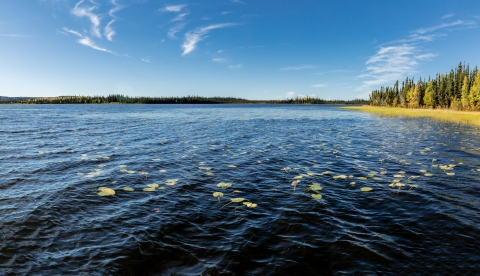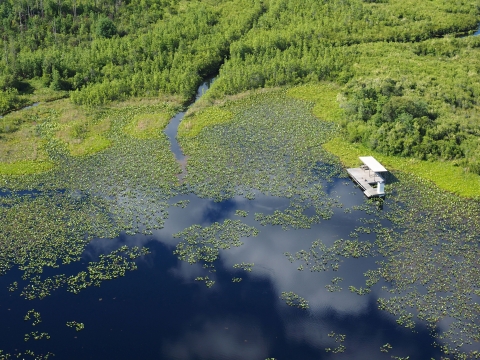Wonder what it's like to pitch a tent under the stars? Disconnect and tune in to nature — at least for a few days?
Maybe now’s the time to get away and go camping at a national wildlife refuge national wildlife refuge
A national wildlife refuge is typically a contiguous area of land and water managed by the U.S. Fish and Wildlife Service for the conservation and, where appropriate, restoration of fish, wildlife and plant resources and their habitats for the benefit of present and future generations of Americans.
Learn more about national wildlife refuge .
Some national wildlife refuges from Alaska to Florida offer rental cabins or campsites in a variety of natural wildlife settings. Here is a sampling of these opportunities
The National Wildlife Refuge System, managed by the U.S. Fish and Wildlife Service, conserves America’s wildlife and the places they need to survive, providing unparalleled outdoor recreational opportunities for all Americans.
Alaska
Kenai National Wildlife Refuge
Want to pack a tent into the wilderness? Or would you rather stay in your RV? Kenai Refuge has it all. The refuge features over 120 RV and tent sites. Camping fees apply at Hidden Lake and Upper Skilak Campgrounds. Some sites can be reserved through Recreation.gov. Senior and Access Passholders receive a 50% discount. The remaining 8 campgrounds in the refuge operate on a first-come, first-served basis and are free.
You can also reserve one of the refuge’s 14 public use cabins. Access to the public use cabins varies from a ¼-mile walk or ski to fly-in-only options. All of the cabins provide genuine Alaskan experiences.
Kodiak National Wildlife Refuge
The refuge does not have any campgrounds, but it does offer a variety of public use cabins. Cabins are a wonderful way to enjoy the refuge and access excellent fishing and hunting areas. Kodiak Refuge's 10 public use cabins are only accessible via boat or floatplane. There is no road or trail access to the refuge’s cabins. Each cabin is equipped with oil stoves for heating, pit-style toilets, and separate meat caches (cabins do not have electricity, plumbing, or cookstoves). Learn about and reserve a cabin at Recreation.gov.
Tetlin National Wildlife Refuge
The refuge has two campgrounds along the Alaska Highway that open once roads are cleared of snow (usually in April). The campgrounds stay open until mid-autumn, usually early October, while roads are still passable. Six public-use cabins are available year-round when they are not being used by staff for management activities. Contact the refuge office at 907-883-5312 to get a permit to stay up to 14 consecutive days. A lottery system has been instituted for the fall moose hunting season (generally late August to mid-September) when demand is especially high. Drawings for the moose season are held a year in advance in October.
Georgia
Okefenokee National Wildlife Refuge
Paddling the beautiful and mysterious swamp of Okefenokee Refuge, a protected wilderness area wilderness area
Wilderness areas are places untamed by humans. The Wilderness Act of 1964 allows Congress to designate wilderness areas for protection to ensure that America's pristine wild lands will not disappear. Wilderness areas can be part of national wildlife refuges, national parks, national forests or public lands managed by the Bureau of Land Management.
Learn more about wilderness area , is the experience of a lifetime. Alligators glide through tea-colored water. Herons and egrets wade through tall grasses and water lilies. You can reserve one of the seven overnight shelters available in the swamp’s interior. Make reservations up to two months in advance by calling 912-496-3331 Tuesday-Thursday, 7-10 a.m. Eastern Time. Learn about permit requirements at Recreation.gov.
Canoeing to a camping platform isn't the only way to overnight at Okefenokee. Stephen C. Foster State Park, located within the refuge, offers cabins and RV and tent camping. For visitors coming from outside the area, it's a great place to stay the night before a canoe camping trip.
Piedmont National Wildlife Refuge
The refuge, in central Georgia about 25 miles north of Macon, allows camping and open fires in designated campgrounds in conjunction with its big game and turkey hunts (pdf). The refuge also allows Scout groups to camp when they are working on a service project outside of hunting season. A refuge hunt permit is required to enter.
Florida
St. Marks National Wildlife Refuge
Hikers can apply to use one of the primitive campsites available along the 56-mile refuge segment of the Florida National Scenic Trail, which passes through two designated wilderness areas. Campers must commit to hiking the entire refuge segment of the trail, which goes through a greater variety of forest and wildlife habitat than any other north Florida section of the trail. The trail follows a series of dikes built to provide freshwater for the thousands of waterfowl that winter here. Hikers may also see osprey, otter, turkey, alligators, fox and some of the more than 300 species of birds found here; 98 bird species nest on St. Marks Refuge. Through-hikers must have a Florida trail permit.
Illinois
Crab Orchard National Wildlife Refuge
Oak-hickory forest covers more than half of the 44,000-acre refuge, while 20 percent is open water. Here you can find hiking trails, nesting bald eagles (best seen in winter), an elusive bobcat and a thriving population of wild turkey. Summer is the perfect time to see and hear songbirds. Autumn brings large numbers of white-tailed deer. Four campgrounds on the refuge, including Crab Orchard Campground, are open April 1-October 31. Grills are available. Electrical and sewer systems have been upgraded.
Maine/New Hampshire
Umbagog National Wildlife Refuge
Spanning northern New Hampshire and reaching into western Maine, the refuge has extensive wetlands vital to waterfowl. In 1972 part of the wetlands at Harper’s Meadow was designated as a Floating Island National Natural Landmark National Natural Landmark
The National Natural Landmarks Program preserves sites illustrating the geological and ecological character of the United States. The program aims to enhance the scientific and educational value of the preserved sites, strengthen public appreciation of natural history and foster a greater concern for the conservation of the nation’s natural heritage. The program was established in 1962 by administrative action under the authority of the Historic Sites Act of 1935. The first National Natural Landmarks were designated in 1963. Today, there are more than 600 National Natural Landmarks in 48 states, American Samoa, Guam, Puerto Rico and the U.S. Virgin Islands.
Learn more about National Natural Landmark . Shoreline campsites are operated by the state of New Hampshire. Camping is by reservation only. For information, visit the state parks website or call 603-482-3906.
Montana
Red Rock Lakes National Wildlife Refuge
Enjoy spectacular scenery in remote wilderness. Trumpeter swans are resident year-round. Aspen and willow trees turn golden in fall. The refuge maintains two primitive campgrounds, with no electricity. The Lower Lake Campground has toilets, picnic tables and fire rings and is the best place to see water birds. Both campsites are available for a minimal fee on a first-come, first-served basis. Be bear aware: Grizzly bears are present on all areas of the refuge, including forest, willows, grasslands, wetlands, lakeshores and creeks. Carrying bear spray on your person and knowing how to use it is strongly recommended.
Nevada
Desert National Wildlife Refuge
Fee-free camping may be the best way to enjoy this 1.6-million-acre refuge in southern Nevada. The refuge, encompassing six major mountain ranges, teems with wildlife, including more than 500 plant species. The land has been home to indigenous people for thousands of years. Look for collared lizards sunning on rocks, some of the 320 species of birds, or the tracks of an elusive mountain lion. Here are some tips for seeing desert bighorn sheep. Six primitive campsites are available on a first-come, first-served basis. Each site has a picnic table, fire ring and tent pad. Vault toilets are available. Bring your own water.
Oklahoma
Wichita Mountains Wildlife Refuge
Known for its reintroduction of bison, elk and wild turkey and some of the finest rock climbing in the area, the refuge offers a choice of camping options. For group reservations at campsites, contact the visitor center at 580-429-3222.
- Doris Campground is a modern camping facility with individual and group sites.
- Fawn Creek Campground is reserved for organized youth groups, including through the university level.
- Backcountry camping is available in the Charon's Garden Wilderness Area.
Washington
Willapa National Wildlife Refuge
Established in 1937 to protect migrating birds, the refuge includes salt marsh salt marsh
Salt marshes are found in tidal areas near the coast, where freshwater mixes with saltwater.
Learn more about salt marsh , forest, freshwater wetlands, streams, grasslands, coastal dunes and beaches. More than 200 bird species nest, rest or winter here. Chum salmon, Roosevelt elk and more than a dozen amphibian species are also resident. On Long Island, an oasis within the refuge, you can find five primitive campgrounds with a total of 20 campsites, offered on a first-come, first-served basis. Each campsite includes a picnic table, fire ring and access to a nearby non-flushing toilet. During high tide, the island is accessible only by boat or kayak.






